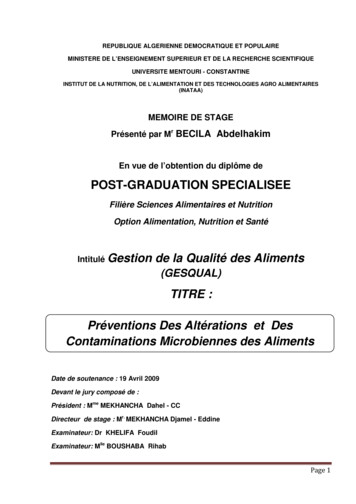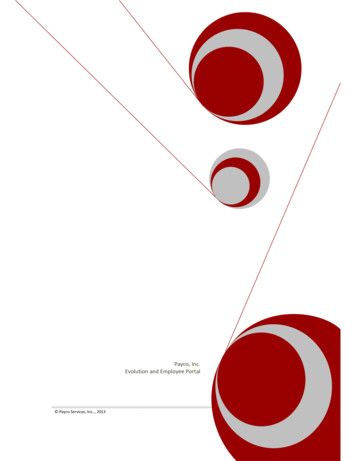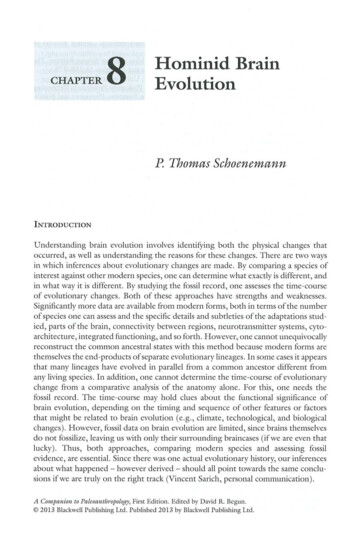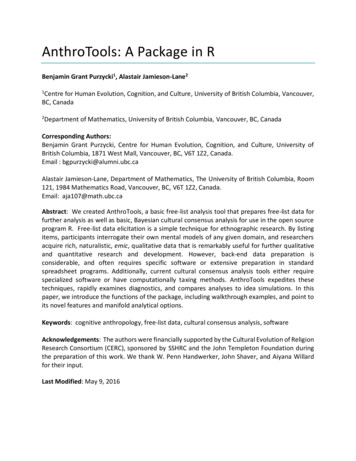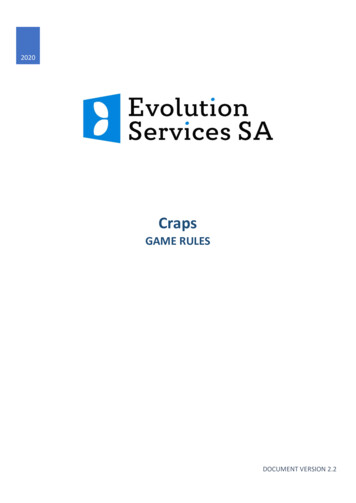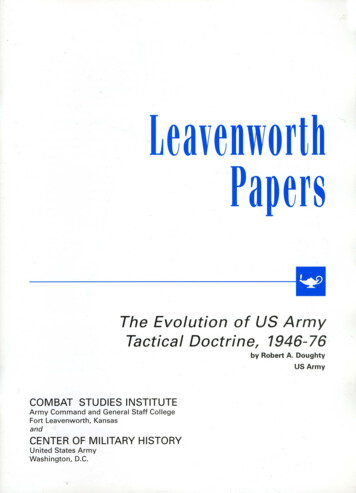
Transcription
FOREWORDIn June 1979, the Combat Studies institute was formed within the USArmy Command and General Staff College. Among its several missions, theinstituteis charged by the commander,US Army Training and DoctrineCommand, to undertake historical research into problems having a bearingupon the concerns of the modern Army and to disseminate the fruits of thisofresearch throughoutthe Army. Major Robert A. Doughty’s, The EvolutionUS Army Tactical Doctrine,7946-76, is the first of a series of studies calledPapers to be published under the auspices of the Militarythe LeavenworthReview.It is fitting that this inaugural study of the Combat Studies Institute shouldfocus upon the formulationof doctrine since World War II. In no comparableperiod in history have the dimensionsof the battlefield been so altered byrapid technologicalchanges. The need for the tactical doctrines of the Army toremain correspondinglyabreast of these changes is thus more pressing thanever before.Future conflicts are not likely to develop in the leisurely fashions of thepast where tactical doctrines could be refined on the battlefield itself. It is,therefore,imperativethat we apprehendfuture problems with as muchaccuracy as possible. One means of doing so is to pay particular attention tothe business of how the Army’s doctrine has developed historically,with aview to improving methods of future development. This study is the first stepalong the road.J , R. THURMANDireCtOrLieutenantColonel Willlam A StafftJohn F MorrrsonProfessorof Milifary HisforyDr. Ira 0. GruberChief, ResearchCommirreeMajor Charles R ShraderResearch FelfowsDr. Allen F. ChewDr. Roger J. SpillerChidleachingCommtrteeMajor(P) Davrd M GiantzTeaching FeltowsMajor Robert T FrankMalor Robert K. Grlfflth, Jr.Malot Thomas W. SweeneyCaptam John C BrnkleyDr. Robert H. BerltnOr Edward J. DrealSG(P) Kenneth Chaws. JrstaffMajor Stanley L WalkerSFC Nelson C RogersMrs. Lana S. KielmonThe LeavenworthPapersare issuedirregularlyby the Fellows of the Combatan elementof ral Staff College, Fort Leavenworth,Kansas 66027. Publicationis under of the Militaryviews expressed in this publicationarethose of the author and not necessarilythose of the Departmentof Defense orany elementthereof.Request for ad or for permissiontoditionalcopiesPapers in whole orreprint Leavenworthpart should be addressed to the Director,Combat Studies Institute, United FortCollege,66027.
The Library of Congress has catalogeding of this title as foIlows:the first print Doughty, Robert AThe evolution of US Army tactical doctrine, 1946761byRobert A. Doughty. - Fort Leavenworth, Kan.: CombatStudies Instikte,US Army Commandand GeneralStaff College, 1979.57 p.; 25 cm. - (LeavenworthIncludes bibliographicalpapers; no. 1)references.1. Tactics. 2. Militaryart and science-UnitedStates-History-20thcentury. 3. United States. Army--I% tory-29th century. I. United States. Army Command andGeneral Staff College,, Fort Leavenworth, Kan. CombatStudies Institute. II. Title. III. braryForof Congresssale by the Superintendentof Document.U.S. GovernmentPrintingOffice,WashingtonD.C. 20402
CONTENTSPAGE127121925294046INTRODUCTEONTHE ARMY, 1945-50ADAPTATION DURING THE KOREAN WARTHE OPENING QFTHEATDMICERATHE ROAD CONCEPTCOUNTERlNSURe NCYTHEVIETNAMWARTHE RETURN TOTHECONVENTIONALCONCLUSION
n of US Armyoctrine,946-76Tacticalby MajorRobertA.f,-?a?Doughty1US Army1 HE tactical doctrine of the US Armychanged considerably between 1946 and1976.The changeswhich took place were in fluenced by a variety of factors, includingimproved conventional weapons, increasedmobility, the development of nuclearweapons, the desires of different militaryleaders, wartime demand, parochial clashesbetween various branches, interservicerivalry and evolving nationa security policy.The competing or conflicting demands ofthese various influences often affected theformulation and dissemination of tacticaldoctrine. Army doctrine evolved amid greatcycles of change, with new methods appear ing only to be overwhelmed by theresurgence of older methods or the ap pearanceof even newer methods. AlthoughEurope remained the center of its primaryconcerns, virtual revolutions in tactical doctrine occurred in the late 195Os,early 1960sand early 197Os,as the Army shifted thefocus of its doctrine from conventional, tonuclear, to counterinsurgency, to conven tional operations. The combination of thesechanges has contributed to modern Armytactical doctrine being more complex than atany other time in American history.The purpose of this study is to describeand analyze the major trends in Army doctrine since Warld War II. While the develop ment of doctrine for individual branches is-I important, this study avoids a detailedanalysis of the narrower aspectsand concen trates on broader themes or issues in theevohnion of US Army tactical doctrine.Since the development of tactical organiza tion and equipment cannot be separated ar tificially from tacticaI methods, the studyalso describesthe major organizational andweaponry changes which were an integralpart of doctrinal innovations.Throughout the period under study, thegeneral purposes of doctrine remainedrelatively unchanged. Doctrine continued toprovide guides for action or to suggestmethods that would probably work best.Similarly, doctrine facilitated communica tion between Army officers, for it definedterms and provided concepts which enabledthe numerous arms on the battlefield to acttogether in a coherent manner or to be suc cessfuhy orchestrated.Sincedoctrine is also that which is official ly approved to be taught, it provided theprimary content of the curriculum of the Ar my school system. Doctrine also assistedinthe development of organizations andweapons systems, for it established thepotential functions of the various systemsand the parameters under which units wereorganized. This enabled the Army’s leadersto favor the development of a particularorganization or weapon system. Doctrinehas thus affected several widespread and im portant aspectsof the Army.By examining broad themes in the evolu-
tion of tactical doctrine, significant insightscan be gained which can help the Army of ficer understand and apply contemporarydoctrine. Indeed, the evolution of tacticaldoctrine illustrates that the great value ofdoctrine is less the final answers it providesthan the impetus it creates toward develop ing innovative and creative solutions for tac tical problems on future battlefields.Il. THE ARMY, 1945-MN THE years between World War II andKorea, the Army carefully consideredits tac tical doctrine, but its methods remainedessentially those of World War II. While thepostwar strategic environment encouragedthe reconsideration of doctrine, it also madethe formulation of Army doctrine especiallydifficult.Since the American atomic monopolyseemed to have provided the perfectresponse to any threat, many Americansquestioned the need for large ground forces.Many believed an act of aggressicmwouldresult in all-out war which the United Stateswould inevitably win with its atomicweapons. Given the Air Force monopolyover the delivery means for these weapons,the Army’s potential contribution seemedmuch less than in the past, and questionsconcerning its tactical doctrine also seemedless important. The introduction of atomicweapons seemed to forecast the demise ofground combat.The Army, nevertheless, argued that itscontribution in any future war was indispen sable. The War Department Board of 1946on Army equipment, headed by GeneralJoseph W. Stilwell, stated that the next warmight open with a surprise attack whichwould be followed by “retaliation withbombing, long range missiles, and biologicalweapons.’ ’ Yet the ultimate victory couldonly be achieved by “occupation of thehostile territory.‘“lIn 1949, General Omar N. Bradley, theArmy chief of staff, envisioned a war occurring in three stages. In the first stage, the-2-United States would employ its strategicweapons against the enemy, and, in the sec ond, American military forces would seizestrategic bases from which the enemy’shomeland might be bombed or from whichthe enemy might bomb the United States.Airborne forces, because of their strategicmobility, would be especially useful in thissecond phase. The third and fina phasewould be a large-scale ground assault todefeat the enemy.*Consequently, from the Army’s viewpoint, ground combat was far from ob solete. A final victory could still be gainedonly by rather traditional ground opera tions, and the World War II experience,especially in the European theater, remaineda valid basis for postwar doctrinal develop ment.Accordingly, as part of its energetic attempt to demonstrate the need for a groundcombat capability, the Army carefullyreviewed its experience in the recent warthrough a series of postwar conferencesdesignedto improve its weapons, tactics andorganization. Perhaps the most commoncharacteristic of these conferences was theirassumption that ground combat would COR tinue to be nonatomic, for the Army did notchange its doctrine to reflect an atomic bat tIefield. The 1949 Field Service Regulations(Field Manual (FM) lOO-5),for example, in cluded only a discussion on the dangers ofradiation and of radioactive materials andsaid nothing about tactics on the atomic bat tlefield.’Instead, when the Army initially con sidered the range of possible battlefields ortypes of combat in which it might par ticipate, the major consideration was terrainrather than different types of combat along aspectrum of warfare. The Army had justparticipated in a global war, and the broad,worldwide responsibilities of rhe UnitedStates after the war indicated that the Armymight fight again in widely varying types ofterrain.The 1949 Field Service Regulationsdiscussed “special” operations in towns,woods, mountains, extreme cold, jungle and
desert, but it considered the “basic prin ciples of combat” applicable to each opera tion. While methods would differ, the essen tial features of conventional warfare wouldcontinue to apply. If there was an exception,it was “partisan warfare,“4 but the manual’streatment of this subject hardly divergedfrom its treatment of other conventionaloperations.Acceptance of widely varying possibletypes of battlefields soon dissipated. .4s thelate 1940swaned and accelerating events ofthe Cold War raised the specter of a Sovietinvasion of Europe, that. Continent becamethe focal point for Army doctrine. Concernfor European security as the most importantstrategic problem thus reinforced the Army’sdoctrinal preference for large-scaleconven tional operations. Although the Army didnot rule out the possibility of operationselsewherein the world, its doctrine was in creasingly oriented toward a European-typebattlefield reminiscent of World War II.The doctrine for the European theater wascreated in North Africa, developed in Italyand polished after the Normandy invasion.The actual procedures employed by theground forces, however, were often ad hocand varied widely from unit to unit.In the war in the Pacific, the Army prof ited from the Marines earlier experienceand quickly developed a fire support coor dination standing operating procedure forarmy, corps and division levels6 This doctrine differed from that employed in theEuropean theater. Following the war,General Jacob L. Devers, chief of Armyground forces, stressedthe integration of allavailable fire support means. FM 31-35, ,4irGroundOperations,was published inAugust 1946,’ and, in December 1949, theArmy published its first training circular onfire support coordination.Formulation of the doctrines on fire support coordination and air-ground operationsdid not occur without serious disagreementsbetween the Army and the newly independ ent Air Force. A major object of conten tion was the tactical air control party(TACP). The Artillery School maintainedthat a TACP should be provided on the basisof one per infantry and armored battalionand should be “organic to the direct supportartillery battalion.” The school also arguedthat observers in ‘“artillery planes” shouldbe able to perform the function of forwardair controllers. It also objected to theestablishment of separate air control netsand argued that requests for tactical air support should be handled like any other firesupport request.%The final solution favored the Air Forceposition, for only one TACP was furnishedto a regiment. The Air Force kept its forward air controllers, as well as operating aseparateair-request net. It was not about torelinquish some of its newly won in dependenceto the artillery.While every potential problem had notbeen resolved, important progress had beenmade in establishing a clear doctrine for tac tical air support of ground troops. Consider ing the intensity of the interservice rivalry* * *The requirement for closely coordinatedand effective firepower emerged as one ofthe primary lessonsof World War II. Conse quently, the problem of fire support coor dination was studied in detail after 1945.Prior to the war, artillery had beenthe majorsupporting weapon for land operations, butthe events of 1939-45demonstrated that tac tical air and naval gunfire could also furnishimportant fire support. Following WorldWar II, the number of artillery tubes was increased from four to six in the battery, andthe cannon company in the infantry regi ment was eliminated. A new method of ad justing on the observer-target line, convertedto the gun-target line by use of a target grid,was introduced at the Artillery School atFort Sill, Oklahoma. Used earlier by balloonobservers,this method facilitated the controlof naval gunfire in joint operations andsimplified the duties of the artillery forwardobserver.5With regard to close air support, no singlesystem of coordination or control had beencommon in all the theaters of World War II.-3-
before the Korean War, this accomplishmentis especially noteworthy. Et stands in sharpcontrast to the pre-World War El era whenonly lip servicehad beenpaid to the problemof air-ground operations by the Army andthe Army Air Corps.Nevertheless, interservice rivalry and thepre-eminent emphasis on the atomic weaponaffected other Army programs. For exam ple, advanceswere made after World War IIwith the helicopter, but those advanceswerenot as rapid as they might have been. Thefew heficopters manufactured in the UnitedStates during the last two years of WoridWar 11 were used primarily for ad ministrative and rescue purposes.9After thewar, the Army conducted studies of thehelicopter at Forts Benning, Sill and Bragg.The 1946 War Department Board on Armyequipment analyzed the capabilities of thehelicopter, but considered its employmentappropriate only for assisting the supply ofairborne troops or for use in ship-to-shoreoperations. I0Although the infantry conference in June1946 at Fort Ben&g a&o studied thehelicopter, its report described the new aircraft as “particularly adaptable to usessuchas supply and evacuation, reconnaissance,observation, photography, column control,wire laying, and liaison and courier mis sions.“‘L Since the existing helicopters werevery small and fragile, it was difficult foranyone to envision their playing an impor tant combat role in large-scale ground opera tions.With the postwar reorganization of theWar Department, the Army agreed to procure all its air vehicles through the newlyformed US Air Force. However, with the advent of the “Big Bomber” and the atomicbomb, there was little room for thehelicopter. When Lieutenant General JamesM. Gavin discussedthe development of thehelicopter with the director of requirementsfor the Air Force, he was told, “Thehelicopter is aerodynamically unsound. . . .No matter what the Army says, I know thatit does not need any.“”The development of the helicopter fell to-4-the Marine Corps which saw the new aircraftas a means of adapting its amphibious warfare operations to the Atomic Age. Whenthe Korean War came, the Marines were bet ter prepared to employ their helicopters forcommand and control, medical evacuation,supply, etc. In September 1951, the Marinesused helicopters in an airmobile operationfor the first time.‘) On the eve of the KoreanWar, however, the Army’s methods con tinued to resemble those of World War II.Steps were taken to improve air-groundcooperation, but the Army developed nodramatically new concepts or weaponsystems.* * *One of the most important and enduringconcepts to emergefrom the severalpostwarstudies concerned the role of the tank. The1946 Stilwell Board concluded, “The bestantitank weapon is a better tank.“‘” Thisconclusion was strongly supported by an ar mor conference of the same year and by aninfantry conference which recommendedthat the antitank company be deleted fromthe infantry regiment and three tank bat talions be assigned to each infantrydivision.15 The artillery conference of 1946also recommended that the armored armmostoftheantitankassumeresponsibilities. I6 Along with the otherstudies, the General Board of the UnitedStates Forces in the E.uropeanTheater statedthat “the medium tank is the best antitankweapon.“” Perhaps the most remarkableaspect of this conclusion was the relativelywide and uncontested support for the tank asthe best antitank weapon.While the armor protection, firepowerand mobility of the tank made it an effectiveantitank system, its presumed superiority inthis role was not based solely on its owncapabilities. It was also based upon theperceived failure of the American antitankgun and self-propelled antitank destroyer inWorld War II. The primary antitank gun ofthe US forces during the war bad been the57mm gun, but this gun had not performedin a completely satisfactory manner. The
General Board of the European Theater, forexample, concluded, “Lack of cross-countrymobility, coupied with the fact that thepenetrating power of the 57mm projectile isinsufficient to stop the modern tank, makesit imperative that another weapon besubstituted.““8During World War II, the Army haddeveloped self-propelled tank destroyers onwhich were mounted effective antitank gunsf3-inch, 76mm and 9Qmm)long before thoseguns were mounted on tanks. Yetwidespread dissatisfaetionwith tankdestroyer units resulted in their disbandingfollowing the war. The Stilwell Board coneluded, “The thin-skinned, self-propelledtank destroyer has too limited a role to warrant further development now that com parable gun power can be attained in tankdevelopment.‘“’In comparison with the 57mm gun and theself-propelled tank destroyer, the bazookahad performed extremely well. The GeneralBoard of the European Theater noted,however, that the primary function of thebazooka had been as an assault weapon andthe secondary function had been as an antitank weaponZoAlthough a 3.5inch bazookahad been introduced toward the end of thewar to replace the 2.36-inch weapon, and arecoilless rifle had also been developed dur ing the war, there was no move to designateeither of these weapons as a primary antitank weapon. Rather, they would be usedtosupplement the medium tank which wasviewed as the primary antitank weapon. Incontrast to the perceptions of other nationsof the world, the United Statesconcluded, ineffect, that it could manufacture a tank thatcould outshoot and outmaneuver othertanks of the world.In its reconsideration of armored warfare,the Army concluded that there had not beenenough infantrymen in the World War II ar mored divisions or enough tanks in the in fantry division. It soon authorized four ar mored infantry battalions (with four infan try companies in each battalion) for eachar mored division. This increased the numberof infantry companies in the armored divi--5--sion from nine to 16. While the infantry divi sion was suited for a wide range of respon sibilities, it could engage, according to thedoctrine, in “decisive operations” in manysituations only if it were supported by otherarms.2iThe experience of World War II reinforced this perception. The General Boardof the European Theater, for example, con cluded, “The uniformly better performanceof infantry, in any operation, when closelysupported by tanks is probably the biggestsingle tactical lesson of the European campaign.rt22Accordingly, the postwar solutionwas to add tanks to the infantry division,and, by the iate 194Os,the infantry divisionhad an organic tank battalion, plus one tankcompany per regiment.The postwar review thus strongly reaf firmed the need for combined arms opera tions. The 1949 Field Service Regulationsrepeated a phrase which had often appearedin prewar manuals: “No one arm wins bat tles. The combined coordinated action orteam work of all arms and services is essen tial to success.” This injunction notwithstanding, the most important elementwithin the combined arms team was the in fantry which remained the center of focus ofUS Army doctrine. There was no intentionto form Iarge armored formations, and, if anarmored division was employed, it would bewithin an infantry-heavy corps in whichthere was one armored division and two orthree infantry divisions. The tank haddemonstrated its potential in World War II,but the infantry remained the “queen of battie.”* * *As for its concepts for the conduct ofground operations before the Korean War,Army doctrine emphasized the offensive.“The purpose of offensive action,” accord ing to the 1949Field Service Regulations, “isthe destruction of the effectiveness of theenemy’s armed forces and of his will tofight.“23 The Field Service Regulations alsostressed the envelopment over the penetra tion and explained, “When the situation
does not favor an envelopment, the main attack is directed to a penetration of the hostilefront.” Selection of the envelopment or thepenetration would be made only after acareful estimate of the situation. If apenetration was necessary, its objectivebecame that of enveloping one or more ofthe flanks created by the breakthrough.t4Army tactical doctrine for the defensewasmuch more specific than that for the of fense, but only one type of defensewas con sidered. Although it had no precise name,this defense was essentiaElyan area defensewhich resembled 6. F. C. Fuller’s “ar chipelago” defense. The major purpose ofthe defense was to maintain control of ter rain, and the doctrine envisioned the selec tion and organization of a fighting positionwhich was to be held “‘at all costs.” Cover ing forces were to be placed forward of themain battle position to delay and disorganizethe advance of the enemy, as well as todeceivehim as to the true location of the bat tle position.The main battle position consisted of a“zone of resistance”21in which there were aseries of occupied defense areas organizedfor all-around defense.A line along the mostadvanced defense areas was &led the mainline of resistance, but the doctrine envision ed a defense in depth rather than a linearconcentration of forces along the main lineof resistance. Large reserves,especially largearmored formations, were retained to relieveunits in the main battle position, participatein a counterattack or to occupy a rear posi tion. Relatively immobile infantry-heavyforces in the main battle area, however, wereto bear the brunt of the heaviest fighting.When an enemy attacked, he would ini tially encounter the covering forces and thenenter the main battle area. Here, he wouldencounter a defense made up of islands ofresistance which would canalize theattacker’s forces and disorganize thecohesivenessof his attack. If the attack washalted, it would be by defensive forcestoward the rear of the main battle area or bycounterattack.‘6But the objective was to maintain control-6-of terrain, not to destroy the enemy’s forces.The defense was considered a method usedonly to gain time or economize forces inorder to permit the development of morefavorable circumstances under which thedecisive blow would be dealt. UnderAmerican doctrine, defeat of the enemy oc curred through offensive or counteroffensive action which destroyed theenemy’s “effectiveness” and his “will tofight.” Attrition was not necessarily a partof destroying the enemy’s combat effec tiveness, for the ultimate purpose of largerunit operations was destruction of enemyunits not soldiers.* * *Between 1945 and 1950, a number ofchanges thus occurred in Army doctrine.Despite thesealterations, much remained thesame. Notwithstanding the atomic bomband the intense postwar studies of theArmy’s tactics, equipment and organiza tions, the doctrine for the employment ofAmerican tactical units in 1950 effectivelyremained that of World War II.The most important changes were designed to increaseand make more responsivethe firepower available to American groundtroops. Army units became somewhatheavier than they had beenin World War II.However, the extra bulk did not come fromthe creation of more US units because theArmy continued to be small up to the eve ofthe Korean War. Rather, the extra bulkcame from the additional elements designedto increasethe firepower of the infantry divi sion which was the dominant division in theArmy’s force structure.The issues encountered or addressed between 1946and 1950were not germane onlyto that short period. Several of them-invarious forms-remained the concern of AFmy tacticians and doctrine writers for thenext three decades.Problems such as the im pact of atomic weaponry, the changingnature of mobility and the demand forgreater and more accurate firepower wereconstant topics of discussion among Armythinkers. Other perceptions, such as the role
of the tank in aneitank warfare, remainedrooted in the conchrsions reachedduring thisshort period.Relations between the various branchesofservice or Army branches continued to besubjects of controversy. Attempts to for mulate better doctrine (such -asfor fire support coordination) or to develop newweapon systems(such as the helicopter) wereinfluenced by sometimes competing in terests. Questions concerning nationalsecurity pohcy also affected the developmentof Army doctrine. By the late 194Os,Armydoctrine was oriented toward a Europeantype battlefield-an oriemation which variedonly slightly during the next 30 years. Insum, the evolution of tactical doctrine con tinued to be influenced by a variety of con cerns, not all of which were technical innature.ttt, ADAPTATtQNDURINGTHEKOREANWARCCORDING to General MatEhew B.Ridgway, who served as commander of theEighth Army in Korea and US commanderin chief in the Far East, the Army was in astate of “shamefuul unreadiness” when theKorean War unexpectedly began.*’ Exceptfor a single division in Germany, every divi sion had been skeletonized. Infantryregiments were reduced from three to twobattalions, and artillery battalions fromthree to two batteries. Even then, most bat talions were not maintained at 100 percentstrength.As a result of the several studies com pleted after World War II, a tank companywas included in each infantry regiment and atank battalion in each division, but most ofthe tanks bePongingto the first units to arrivein Korea had been stored or deleted from theskeleton units. Equipment problems werecompounded by poor physical conditioningof soldiers and a generai insufficiency oftraining. AH American planning had as sumed that the next war would be a globalwar; according to General Ridgway, “Theconcept of “limiaed’ war never entered our-7-councits.“28 In the initial dark andtumultuous days of this unexpected war,American soldiers paid a bloody price forthis unpreparedness.During the bleak summer and eariy fall of1950, the ground forces, under the doggedleadership of Lieutenant General Walton H.Walker, strove to maintain a semblance ofcohesiveness as they delayed south andeslablished the Pusan Perimeter. Followingthe fnchon landing on 15 September 1958,the tide of the war swiftly reverseditself, andthe United Nations’ (UN) forces rushednorth to the Yam, only to be attacked by theChinese Communists in November. The UNforces delayed south of Seoul but, by April1951I had. again pushed forward to thevicinity of the 38th parallel where theChinese launched another major offensive.By May, the enemy attack had failed, andthe UN forces were again on the offensive.But the fighting soon degenerated into astatic war of position, reminiscent of WorldWar I, which ended only with the cease-fireof 27 July 1953.The first parr of the war was thuscharacterized by relatively mobile operationsas the opposing armies swept up and downKorea. Ahhough comments from leaderssuch as General Walker indicated no realchanges in tactical doctrine or tables oforganization and equipment were needed,29the Army experienced difficulties with itsdoctrine. The combination of the terrain,weather and enemy tactics tended to hamperemployment of much of the tactical doctrineand equipment of the Army which wereoriented toward another world war thatwould be fought primarily in WesternEurope. Major problems were encounteredwith the mountainous terrain, for it limitedthe full use of American mechanized andmotorized might.* * *The enemy’s tactics often took advantageof American weaknesses.The North Koreantactic of envelopment was especially effec tive. In the initial phasesof the war, the thin ly held defensive lines of the Americans had
numerous holes or exposed flanks. Infiltrating enemy units frequently occupiedpositions to the Americans’ rear, strikingcommand posts, support units or artillerypositions. GuerrilEaswere also used. Groupsof about 15 men operated as tactical units,and their raids struck throughout theAmerican rear.”Much of the initial North Korean successresulted from its employment of about fourbattalions of tanks which were often sentboldly forward of the main body. TheAmericans were ill-equipped in the initialfighting to deal with the Russian T34 tankssince the
Tactical octrine, 946-76 by Major Robert A. Doughty US Army HE tactical doctrine of the US Army changed considerably between 1946 and 1976.The changeswhich took place were in fluenced by a variety of factors, including improved conventiona
